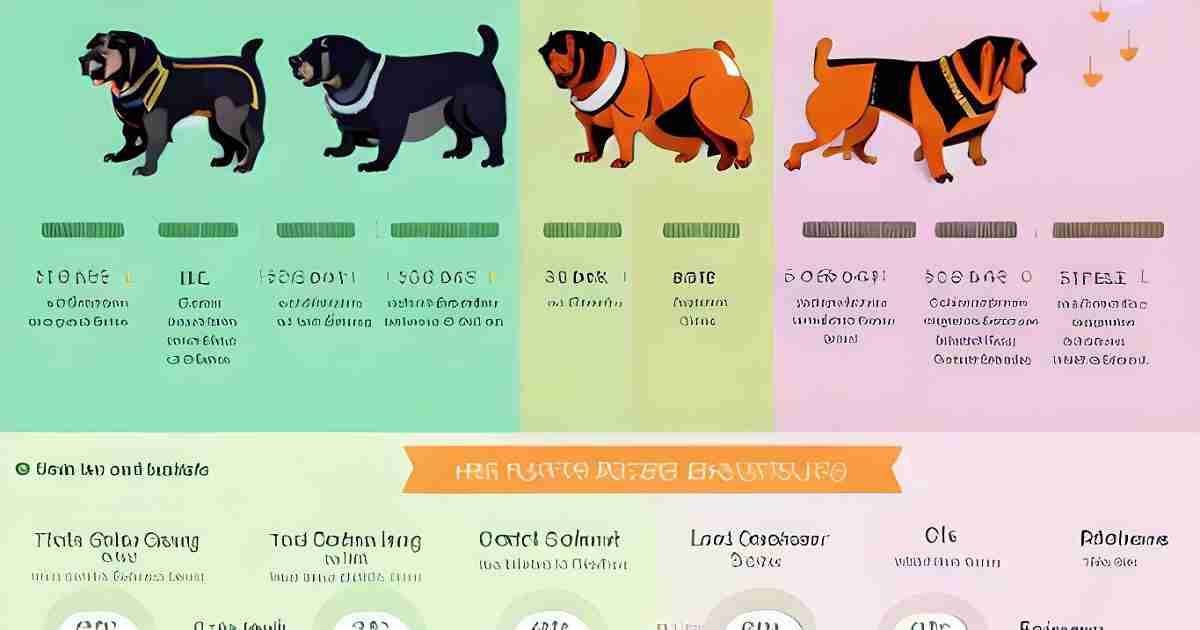From iconic black and tan coats to rare blue coats, Rottweilers come in diverse colors. When people think of this hardworking dog, they usually imagine the familiar black and brown Rottie.
In this post, we’ll explore the genetics behind Rottweiler coat colors. In addition, you will learn how to care for various fur types. You will also discover if fur color tells us anything about their temperament. Get some snacks and sit down with your dog to learn about the different colors of Rottweilers.
A Brief History of Rottweilers
Let’s rewind for a moment to understand where Rottweilers come from.
These loyal pups hail from a town called Rottweil in southern Germany. They were cattle dogs. They drove livestock to the market. They protected the herd from thieves.
Rottweilers have black and tan fur. This fur helps them blend into shadows while guarding cows. Rottweilers almost went extinct in the late 1800s. But a set of breeders revived the dogs. Ranchers, police, and military chose the breed because they were intelligent, powerful, and guarded.
Today, Rottweilers rank as one of America’s most beloved dog breeds. They’re the eighth most popular purebred in the United States.
Now let’s explore the gorgeous coat colors you’ll find with this versatile working breed.
An Overview of Common Rottweiler Colors Coat
Rottweilers sported a sleek, straight double-coat. The outer hairs are coarse, while the undercoat is thick and soft. Their coats come in several colors
- Black
- Mahogany
- Black and tan
- Blue
- Liver
- Isabella
- More unique variants like white, merle, and brindle
But what exactly do these colors look like on a Rottie? Let’s find out!
Black Rottweilers
The classic black coat with rich tan markings tops the most common Rottweiler colors. The instantly recognizable look comes to mind when people picture a Rottweiler.
These ebony canines have a glossy, coal-colored coat. Their markings appear above the eyes, cheeks, chest, legs, and paws. Some black Rottweilers also boast a bold white spot on their chests called a “medallion” or “Blessed.”
Mahogany Rottweilers
At first glance, the deep mahogany coat may look similar to rich black. But this gorgeous tone has more red and brown hues.
Mahogany Rottweilers are sometimes mistaken for liver or brown Rottweilers. Mahogany looks more vibrant and rusty, while liver has chocolate tones.
This exquisite color catches the light beautifully. But mahogany coats are vulnerable to sunburn and fading. Consider limiting sun exposure or using doggie sunscreen to protect your pup.
Black and Tan Rottweilers
The traditional black and tan combo encapsulates the signature Rottweiler look. These dark dogs have black coats with classic tan markings on the face, chest, legs, and feet. Their tan ranges from a light beige to a deep, rich red.
Some black and tan Rottweilers have such minimal tan they appear almost solid black. The striking look provided the perfect palette for their tan points to dazzle and pop.
Blue Rottweilers
Now we venture into the realm of rare and unique Rottweiler coat colors. First up, we have a blue Rottweiler. Instead of pure black and blue, Rotties have a diluted grayish-blue hue.
This unusual tone results from a mutation in a gene called melanophilin. The diluted pigment also causes blue Rottweilers to have blue eyes.
A blue Rottweiler looks cool but has some health risks because of genetics. Dilution alopecia can cause hair loss, although not all blue Rotties are affected.
Liver Rottweilers
The liver is one of the more uncommon Rottweiler colors. These dogs have a rich chocolate, bronze, or cinnamon coat. Like puppies, liver Rottweilers often pass for black. But their coats develop more brown undertones with age.
Liver Rottweilers have noses, eye rims, lips, and paw pads that are liver-colored, not black. Their gorgeous amber eyes also help set them apart.
Even though it’s not ideal for dog shows, breeders purposely breed liver-colored Rottweilers. They make stunning companions.
Isabella Rottweiler
The Isabella Rottweiler flaunts a light, café au lait coat. Their fur may range from pale fawn to creamy tan.
Like blue Rottweilers, isabella has a dilution gene that causes their washed-out color. Some also inherit striking light eyes.
Isabella is a recessive trait. Both parents must carry the gene for an isabella litter to occur. Isabella Rottweilers are getting more popular because they look unique but still need to be more common.
White Rottweilers
The white Rottweiler is one of the rarest and most striking color variations. These snow-coated pups occur due to an absence of pigment. Albino and extreme piebald Rottweilers also appear white.
However, the AKC considers white Rottweilers a disqualification. Breeding white Rotties perpetuates genetic problems associated with coat and vision.
But not all white Rottweilers suffer ill effects. Those who live entire, healthy lives as beloved (if highly uncommon) companions.
Merle Rottweilers
Merle refers to a marbled coat pattern. Dark splotches coat the dog’s lighter gray or blue background.
Merle Rottweilers don’t conform to breeding standards. However, some breeders purposefully produce Merle litters to sell these supposedly unique dogs at higher prices.
However, Merle brings serious health risks like blindness, deafness, and immune disorders. It’s better left to breed genetically predisposed to the pattern.
Brindle Rottweilers
Of all the Rottweiler colors, the brindle is arguably the most stunning…and shocking. Brindles cause black stripes to appear over the background of fawn, brown, or red fur. The striking pattern resembles that of a tiger.
Brindles are extremely rare in Rottweilers. When it occurs, it’s usually caused by crossbreeding far back in a dog’s ancestry. This trait can resurface even generations later.
While gorgeous, there are no true 100% brindle Rottweilers. Ethical breeders do not intentionally mix breeds, which is the only way to create full-bred brindle Rottweilers.
Rottweiler Coat Patterns That Disqualify From Breed Standard
Rottweilers come in many colors, but only specific combinations meet the breed standard.
According to the American Kennel Club, all colors are allowed in Rottweilers as long as black is the base and markings above the eyes, cheeks, chest, legs, and tail tip are tan.
Any white markings on the chest or feet are an automatic disqualification. Coats that are multi-colored or black and tan, and have noticeable rusting or bronzing, are not acceptable for showing. But they can still make perfect companions and therapy dogs.
The Genetic Behind Rottweiler Coat Colors
At a genetic level, different Rottweiler colors occur due to variations in two genes:
The B Locus Gene
The B locus gene determines whether a Rottie’s coat is black (B) or brown (b). Black is dominant, while brown is recessive. Dogs with BB or Bb are black. Only bb causes brown pigment. Liver Rottweilers have bb genes. Their coats appear chocolate instead of true black.
The D Locus Dilution Gene
The D locus gene controls color dilution. The dominant allele (D) produces standard color, while the recessive d dilutes the coat.
Blue and Isabella Rottweilers have added genes. They exhibit the muted grayish-blue or pale fawn caused by a single copy of the dilution allele.
Understanding canine genetics helps breeders thoughtfully cultivate diverse Rottweiler colors. But what about the average Rottie owner? Let’s look at whether coat color impacts anything beyond looks.
Do Rottweiler Coat Colors Indicate Anything About Temperament?
One common myth is that specific Rottweiler coat colors reflect personality traits. For example:
- Black Rottweilers are more aggressive and protective
- Brown Rottweilers have sweeter dispositions
- Multi-colored Rottweilers are friendlier
No scientific evidence connects a Rottweiler’s coat color to their temperament or any breed. A dog’s personality comes from how it is raised and trained and its life experiences.
A blue Rottweiler may attract attention during walks. Still, they can have the same temperament as black or tan dogs if raised and handled correctly.
According to the American Kennel Club’s breeding standards:
The perfect Rottweiler is a strong, medium-sized dog. It is black with clear rust markings. His compact and substantial build denotes great strength, agility, and endurance.
Male dogs are generally bigger, have a larger frame, and have heavier bones than females.” This description fits Rottweilers of any color, not just black and tan.
Caring for Different Rottweiler Coat Colors
Do different Rottweiler coat colors require varying grooming needs?
In most cases, the grooming routine remains the same no matter what hue your dog sports. All Rottweiler coats benefit from occasional bathing and brushing to manage shedding. Trim their nails as needed (typically every 2-3 weeks).
However, some specialty colors may need a little extra care:
- Blue Rottweilers: Dilution alopecia increases the risk of dry, itchy skin. Use a moisturizing conditioner when bathing.
- Isabella Rottweiler: Their pale coats are prone to sunburn. Limit sun exposure and apply dog-safe sunscreen before outdoor play.
- White Rottweilers: Lack of pigment also makes them sun-sensitive. Take the same sun protection precautions as with Isabella.
Genetics are the main factor in how long it takes to care for your Rottie’s coat. Some dogs naturally shed more than others. Regular brushing, especially during seasonal shedding cycles, helps keep excessive hair at bay.
Showing Rottweilers With Non-Standard Coat Colors
Exhibitors of Rottweilers with different colors or markings find the AKC breed standard challenging. Dogs displaying disqualifying traits like white markings can’t compete in confirmation events.
But confirmation shows judges just a slice of a dog’s potential. Performance venues better demonstrate Rottweiler’s intelligence, athleticism, and abilities.
Rottweilers of any color or pattern can join activities like agility, obedience, and tracking. They must meet the requirements to participate. Many multi-colored Rottweilers thrive as therapy dogs, service dogs, and K-9 officers.
All Rottweiler colors make fabulous family companions and hiking buddies. It’s the perfect place for every well-trained Rottie to shine regardless of coat color.
Responsible Breeding for Coat Color Diversity
Rottweiler breeders face an ethical dilemma: keeping breed integrity or embracing color diversity. Breeding for trendy colors like Merle or Brindle harms the health and temperament of the puppies. However, if we only breed black and tan Rottweilers, we limit the variety of genes.
Responsible breeders thoughtfully outcross dogs of different colors when health testing proves they’re free of preventable disorders. Breeding like this keeps the breed diverse and creates unique colors sometimes.
Such conscientious out crossings gave rise to the striking liver Rottweilers we love today. Rare colors offer a peek at the genetic potential waiting in Rottweiler lines.
A Rainbow of Gorgeous Rottweiler Coat Colors
We’ve explored the black, blue, brown, and white coats making up the Rottweiler rainbow. From common to truly rare, what colors will your next Rottie rock?
Remember that the color of a dog’s coat doesn’t tell us much about their temperament or health. To make Rottie a great companion, breed, care for, train, and socialize them properly.
If you want a loyal, confident, and affectionate dog, choose a Rottweiler. They come in black, rust, or blue merle. Their black, brown, and white shades make them cherished companions with many lovable qualities.
Have you fallen for an unusually colored Rottweiler? Share your experience in the comments! And remember to like and share if you enjoyed this guide to Rottweiler coat colors.
Conclusion
Rottweilers have a distinctive look with their tall shape and attractive fur colors. But as we’ve explored, not all Rotties sport the quintessential black and tan look. From rare blue Rottweiler to rich mahogany specimens,
Rottweilers exhibit diverse and beautiful colorations beyond the breed norm. Various factors, such as genetics, breeding, and luck, contribute to multiple colors, from deep black to light isabella.
People debate if specific colors are preferred, but there’s no evidence that one color is healthier or affects mood more.
You can find great companion dogs in all Rottweiler colors with proper care and training. Coat color offers a point of interest and conversation but does not determine a Rottweiler’s potential.
For those seeking a dog with unwavering loyalty, a courageous spirit, and fun-loving. Charming, Rottweilers fit the bill – no matter their shade.
So if you have a favorite color, by all means, let that guide your search for the perfect Rottie. But rest assured that their hearts and souls shine through equally beneath the coat.
Frequently Asked Questions
What’s the rarest Rottweiler color?
- The rarest color for a Rottweiler is called Isabella. It is a lighter version of the liver, resulting in a faded, silvery gray coat with fair tan points. Only an estimated 2-3% of Rottweilers are Isabella.
Do black Rottweilers have different personalities than other colors?
- There is no evidence that black Rottweilers differ in temperament from other colors. Beyond coat color, personality is shaped more by upbringing, training, and genetics.
Is a blue Rottweiler just as healthy as a black one?
- Blue Rottweilers are as healthy as black ones. They must come from responsible breeders who check for genetic issues. The color blue itself does not cause health problems.
Why are liver Rottweilers discouraged?
- Liver Rottweilers need to meet the breeding standard for showing. But when responsibly bred, they are just as healthy and lovely as black Rottweilers. Color preferences are subjective.
Do mahogany Rottweilers fade as they age?
- After they are puppies, mahogany Rottweilers’ coat becomes a softer shade of red. But they maintain their rich coloring better than black and tan.
What causes the different tan markings in black and tan Rottweilers?
- The genes for pigment cause the different tan markings on black and tan Rottweilers. The markings don’t indicate anything about the dog’s health or temperament.












1 thought on “You Won’t Believe the Stunning Colors Answer to “What Are Rottweiler Colors?”